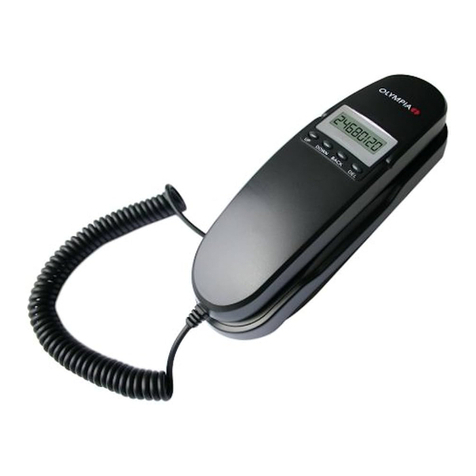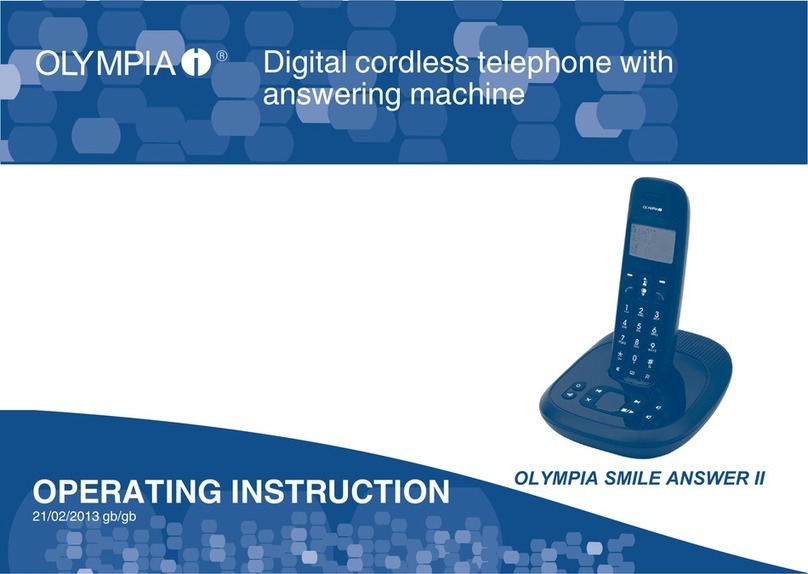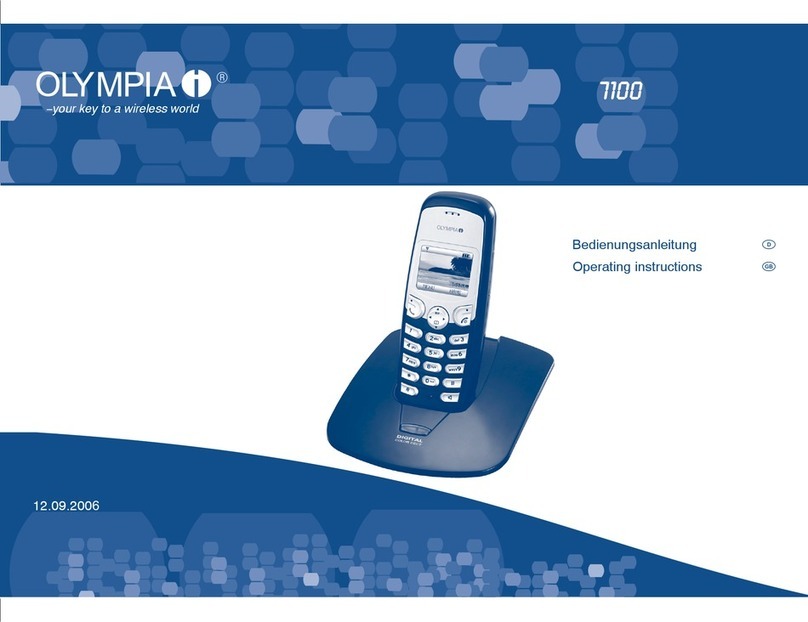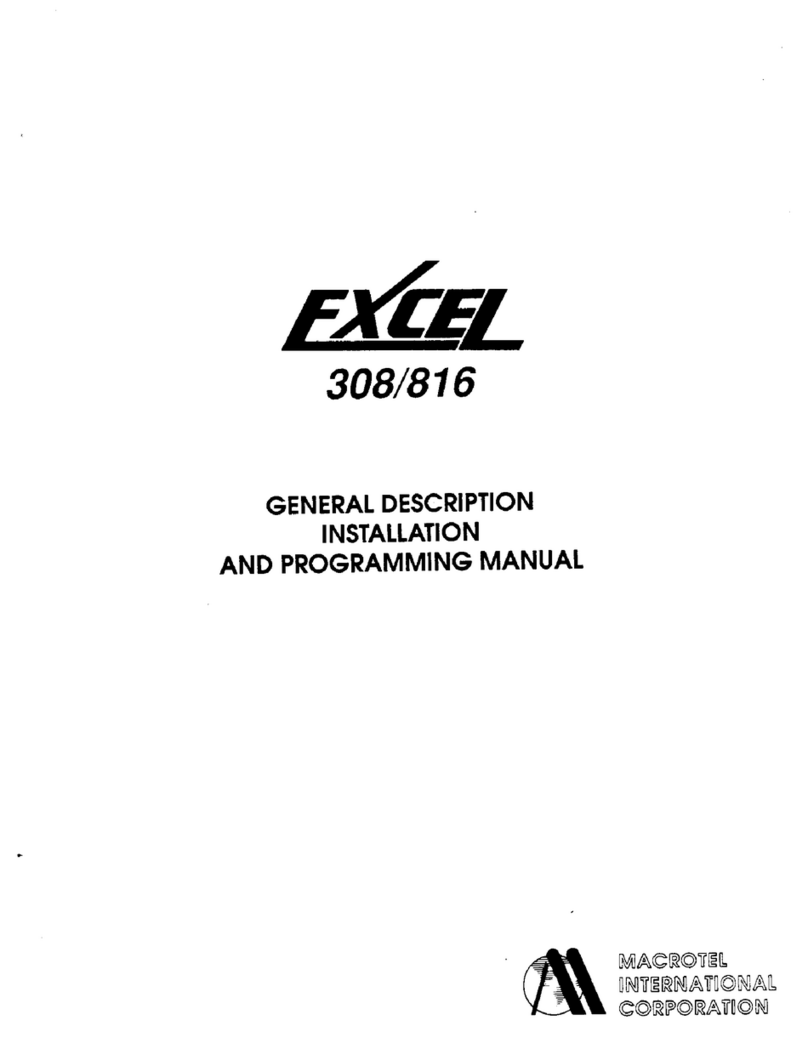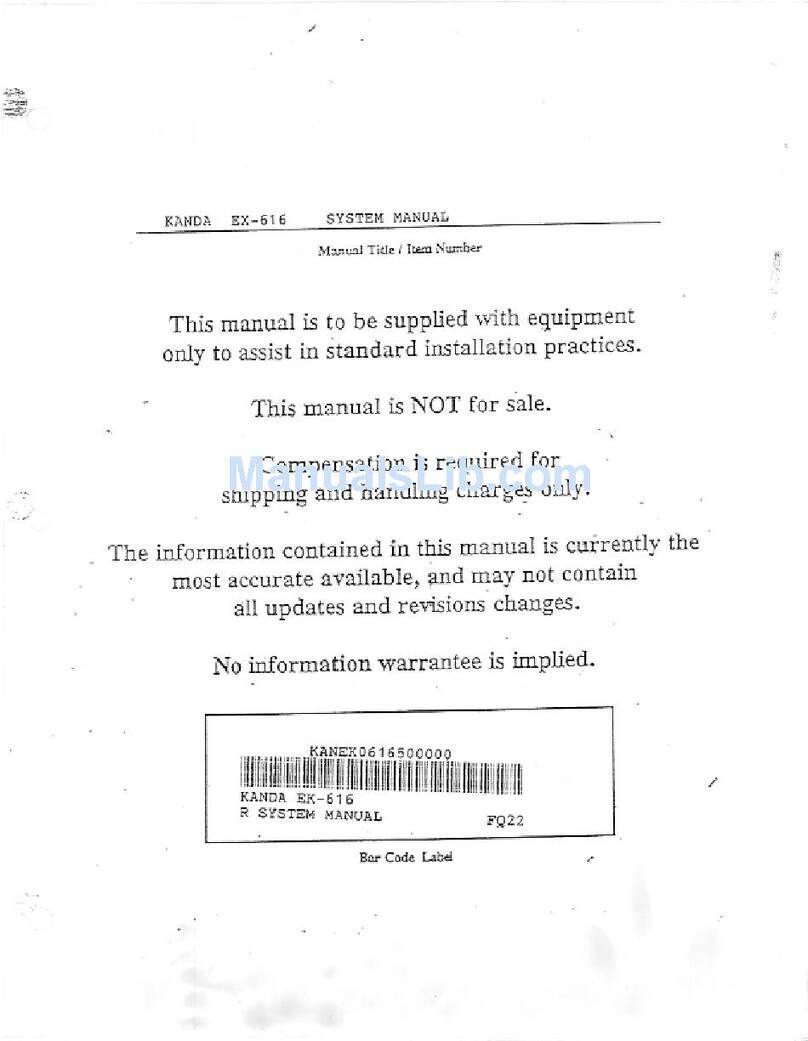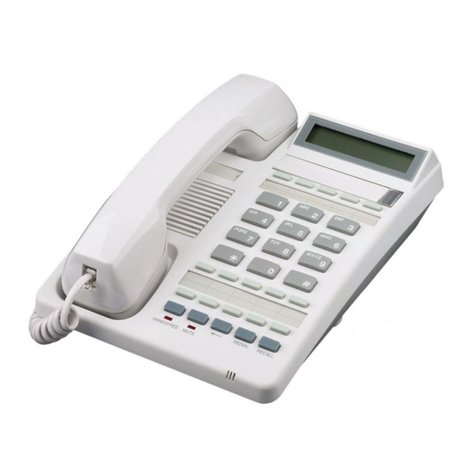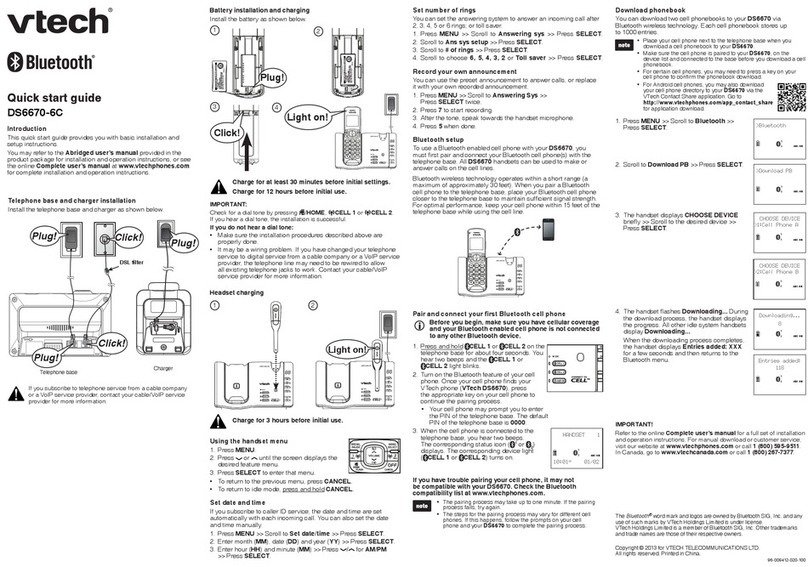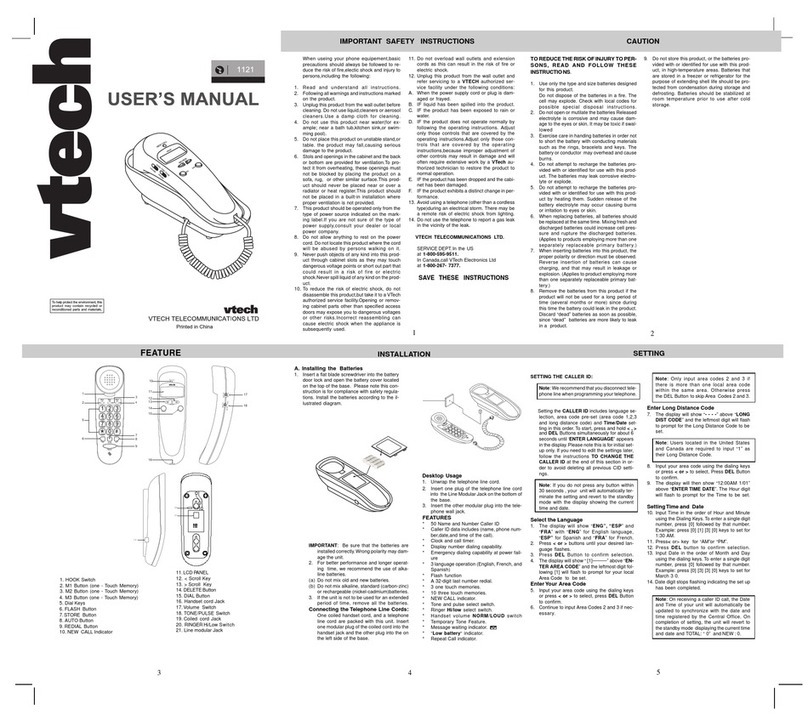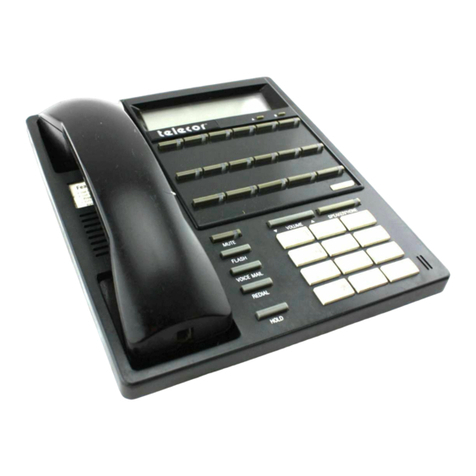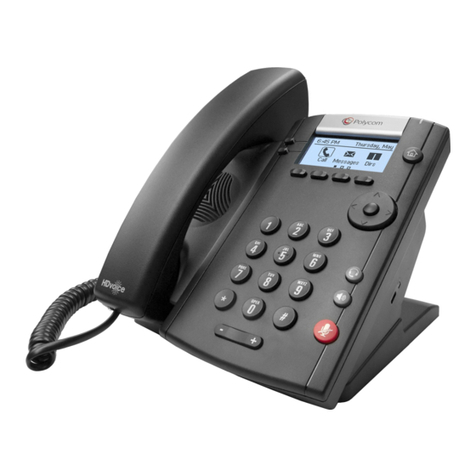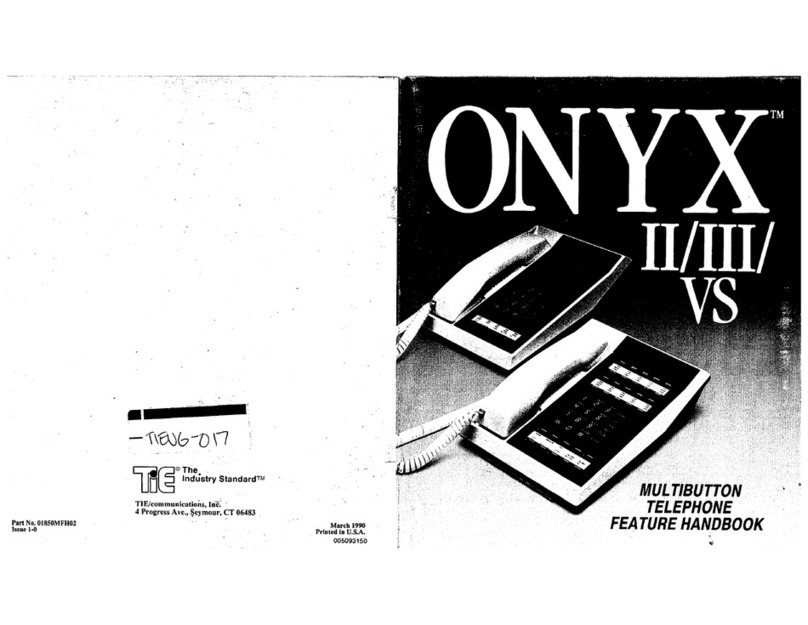Olympia 4310 User manual

RDesk Telephone 4310
4310
Operating Instructions
30.04.2009 en/en


Contents
G
OPERATING
INSTRUCTIONS iPage
Introduction 1. . . . . . . . . . . . . . . . . . . . . . . . . . . . . . . . . . . . .
Important Safety Precautions 1. . . . . . . . . . . . . . . . . . . . . . . . . . . . . . . . . .
Exemption From Liability 1. . . . . . . . . . . . . . . . . . . . . . . . . . . . . . . . . . . . . .
Intended Use 1. . . . . . . . . . . . . . . . . . . . . . . . . . . . . . . . . . . . . . . . . . . . . . .
Information on Disposal 1. . . . . . . . . . . . . . . . . . . . . . . . . . . . . . . . . . . . . . .
Installation 2. . . . . . . . . . . . . . . . . . . . . . . . . . . . . . . . . . . . . .
Package Contents 2. . . . . . . . . . . . . . . . . . . . . . . . . . . . . . . . . . . . . . . . . . .
Positioning and Connecting 2. . . . . . . . . . . . . . . . . . . . . . . . . . . . . . . . . . .
Important Information 3. . . . . . . . . . . . . . . . . . . . . . . . . . . . . . . . . . . . . . . . .
Features 4. . . . . . . . . . . . . . . . . . . . . . . . . . . . . . . . . . . . . . . .
Equipment Description 5. . . . . . . . . . . . . . . . . . . . . . . . . .
Operating Elements and Indicators 5. . . . . . . . . . . . . . . . . . . . . . . . . . . . .
Display 6. . . . . . . . . . . . . . . . . . . . . . . . . . . . . . . . . . . . . . . . . . . . . . . . . . . .
Other Icons in the Display 6. . . . . . . . . . . . . . . . . . . . . . . . . . . . . . . . . . . . .
Menu Structure 7. . . . . . . . . . . . . . . . . . . . . . . . . . . . . . . . . .
Overview 7. . . . . . . . . . . . . . . . . . . . . . . . . . . . . . . . . . . . . . . . . . . . . . . . . . .
Editing Phone Book Entries 8. . . . . . . . . . . . . . . . . . . . . . . . . . . . . . . . . . .
Creating Phone Book Entries 8. . . . . . . . . . . . . . . . . . . . . . . . . . . . . . . . . .
Flash Time 8. . . . . . . . . . . . . . . . . . . . . . . . . . . . . . . . . . . . . . . . . . . . . . . . .
Ringing Melody 8. . . . . . . . . . . . . . . . . . . . . . . . . . . . . . . . . . . . . . . . . . . . .
Babycall (Direct Call) 8. . . . . . . . . . . . . . . . . . . . . . . . . . . . . . . . . . . . . . . . .
Display Contrast 8. . . . . . . . . . . . . . . . . . . . . . . . . . . . . . . . . . . . . . . . . . . .
Date and Time 9. . . . . . . . . . . . . . . . . . . . . . . . . . . . . . . . . . . . . . . . . . . . . .
Long Distance Access Code 9. . . . . . . . . . . . . . . . . . . . . . . . . . . . . . . . . .
Area Code 9. . . . . . . . . . . . . . . . . . . . . . . . . . . . . . . . . . . . . . . . . . . . . . . . .
Language of the Menu Guidance 9. . . . . . . . . . . . . . . . . . . . . . . . . . . . . . .
Telephoning 10. . . . . . . . . . . . . . . . . . . . . . . . . . . . . . . . . . .
Taking a Call 10. . . . . . . . . . . . . . . . . . . . . . . . . . . . . . . . . . . . . . . . . . . . . .
Making a Call 10. . . . . . . . . . . . . . . . . . . . . . . . . . . . . . . . . . . . . . . . . . . . .
Redialling 10. . . . . . . . . . . . . . . . . . . . . . . . . . . . . . . . . . . . . . . . . . . . . . . .
Putting a Call on Hold 10. . . . . . . . . . . . . . . . . . . . . . . . . . . . . . . . . . . . . .
Changing the Receiver Volume 10. . . . . . . . . . . . . . . . . . . . . . . . . . . . . .
Changing the Ringing Volume 10. . . . . . . . . . . . . . . . . . . . . . . . . . . . . . .
Changing the Loudspeaker Volume 10. . . . . . . . . . . . . . . . . . . . . . . . . . .
Compiling the Call Time 11. . . . . . . . . . . . . . . . . . . . . . . . . . . . . . . . . . . . .
Muting the Microphone 11. . . . . . . . . . . . . . . . . . . . . . . . . . . . . . . . . . . . . .
Using the R Button 11. . . . . . . . . . . . . . . . . . . . . . . . . . . . . . . . . . . . . . . . . .
Entering a Dialling Pause 11. . . . . . . . . . . . . . . . . . . . . . . . . . . . . . . . . . . .
Dialling Phone Numbers from the List of Incoming Calls 11. . . . . . . . . . .

Contents
OPERATING
INSTRUCTIONS
G
iiPage
Speed Dial Memory and Phone Book 12. . . . . . . . . . . .
Saving Entries in the Phone Book 12. . . . . . . . . . . . . . . . . . . . . . . . . . . .
Editing Entries in the Phone Book 12. . . . . . . . . . . . . . . . . . . . . . . . . . . .
Saving Phone Numbers from Incoming and
Outgoing Calls in the Phone Book 12. . . . . . . . . . . . . . . . . . . . . . . . . .
Dialling Phone Numbers from the Phone Book 12. . . . . . . . . . . . . . . . .
Deleting an Entry from the Phone Book 13. . . . . . . . . . . . . . . . . . . . . . .
Programming One−touch Dialling Keys 13. . . . . . . . . . . . . . . . . . . . . . .
Dialling with One−touch Dialling Keys 13. . . . . . . . . . . . . . . . . . . . . . . .
Programming the Speed−dialling Keys 13. . . . . . . . . . . . . . . . . . . . . . . .
Dialling with the Speed−dialling Keys 13. . . . . . . . . . . . . . . . . . . . . . . . .
Call Identification (CLIP) 14. . . . . . . . . . . . . . . . . . . . . . .
Call List 14. . . . . . . . . . . . . . . . . . . . . . . . . . . . . . . . . . . . . . . . . . . . . . . . . .
Miscellaneous 15. . . . . . . . . . . . . . . . . . . . . . . . . . . . . . . . .
Alarm 15. . . . . . . . . . . . . . . . . . . . . . . . . . . . . . . . . . . . . . . . . . . . . . . . . . . .
Snooze 15. . . . . . . . . . . . . . . . . . . . . . . . . . . . . . . . . . . . . . . . . . . . . . . . . .
Voice Mail 15. . . . . . . . . . . . . . . . . . . . . . . . . . . . . . . . . . . . . . . . . . . . . . . .
Callback When Engaged 15. . . . . . . . . . . . . . . . . . . . . . . . . . . . . . . . . . . .
Filter 16. . . . . . . . . . . . . . . . . . . . . . . . . . . . . . . . . . . . . . . . . . . . . . . . . . . .
Filter Properties 16. . . . . . . . . . . . . . . . . . . . . . . . . . . . . . . . . . . . . . . . . . .
Operating in a PABX System 17. . . . . . . . . . . . . . . . . . .
In Case of Problems 18. . . . . . . . . . . . . . . . . . . . . . . . . . .
Guarantee 19. . . . . . . . . . . . . . . . . . . . . . . . . . . . . . . . . . . . .
Technical Modifications 19. . . . . . . . . . . . . . . . . . . . . . . .

Introduction
G
OPERATING
INSTRUCTIONS 1Page
Introduction
Important Safety Precautions
Please observe the following to ensure the telephone can be operated
reliably:
SRead this manual thoroughly and observe the instructions and
information in it when operating the unit.
SPlace the telephone on a non−slip base and lay the connection
cables so that they cannot be the source of an accident.
SDo not expose the equipment to extreme temperatures or humid
conditions and protect it from direct sunlight and dusty conditions.
SOnly clean the equipment with a soft, moist cloth. Never use any
solvents or aggressive cleaning agents.
SNever open the equipment. Opening the equipment exposes the
person to the risk of an electric shock and also automatically
annuls any rights to claims under the terms of guarantee.
SRepairs to defect equipment may only be carried out by service
centres authorised by the sales outlet.
SThe equipment is operated electrically. Therefore, never use it
when in a damp or wet condition.
STo prevent the risk on an electric shock, never use the equipment
near bathtubs, showers or similar facilities.
Exemption From Liability
We cannot guarantee that the information which relates to the technical
properties of the product or to the product itself contained in this document
is correct. The product and its accessories described in this document are
subject to constant improvement and further development. For this reason,
we reserve the right to modify components, accessories, technical
specifications and related documentation of the product described herein at
any time without notice.
Intended Use
The telephone is suitable for telephoning within a public telephone network
system.
Any other use is considered unintended use. Unauthorised modifications or
reconstructions not described in this manual are not permitted.
Information on Disposal
The implementation of European law in national laws and directives obliges
you to dispose of consumable goods appropriately. This serves to protect
both persons and the environment.
The adjacent symbol indicates that electrical and electronic
apparatus as well as batteries no longer required must be
disposed of separate from domestic waste.
Old or unwanted devices must be disposed of at collection
points provided by public waste authorities.
Batteries and power packs must be disposed of at shops
which sell batteries or collection points which provide the
corresponding containers.
Packaging materials must be disposed of according to local
regulations.

Installation
OPERATING
INSTRUCTIONS
G
2Page
Installation
Package Contents
Desk telephone 1
Receiver 1
Helix cable 1
Telephone connection cable 1
AA batteries 3
Operating manual 1
Please check the contents of the package carefully. If anything is missing
or shows signs of transport damage, do NOT put the telephone into
service! In such a case, contact your sales outlet, with the purchase receipt
to hand, or the OLYMPIA Service Center directly.
Note: Keep the equipment packaging so that it can be used to prevent
equipment damage in the event of future transport.
Positioning and Connecting
Position the desk telephone where it is easy to access. Ensure that it is set
down on a stable, level, non−slip surface. In addition, ensure that the
equipment is positioned where all the necessary cables can be laid in such
a way that nobody can trip over them. Do not place the desk telephone in
the direct vicinity of other electrical apparatus, such as microwave ovens,
PCs or hi−fi equipment, for example.
Do not expose the desk telephone to direct sunlight. Protect it
from getting wet. The equipment must not be set up in rooms in
which condensation, corrosive vapours or high concentrations
of dust develop and accumulate (e.g. cellar rooms, garages or
winter gardens).
The ambient temperature must be between 0 _C and 35 _C.
Note: Refer to Section Equipment Description for information on the
location of the equipment elements mentioned below.
1. Insert the plugs in the relevant sockets provided on the desk telephone
(they cannot be incorrectly connected because the sockets and plugs
are designed to prevent reverse poling).

Installation
G
OPERATING
INSTRUCTIONS 3Page
2. Plug the telephone line plug in the corresponding socket in the
telephone connection socket.
3. Open the battery compartment and insert 3 AA batteries.
Note: The display lighting is only active when batteries are inserted/fully
charged. If the display no longer functions, change the batteries.
4. Set the volume control switch (E) for the receiver to the required
position. The switch is located on the inner side of the receiver.
Important Information
SDo not mix old and new batteries.
SDo not mix alkaline, standard (zinc−carbon) or rechargeable
batteries.
SIf the telephone will not be used for a longer period, remove the
batteries to prevent damage caused by the batteries leaking.
SEnsure that the batteries are inserted the right way round (refer
to the direction on the diagram in the battery compartment).
Reversed polarity can cause damage to the telephone.

Features
OPERATING
INSTRUCTIONS
G
4Page
Features
We are pleased that you have purchased this high quality telephone which
is equipped with the following features:
SCall identification (CLIP), compatible with FSK/DTMF
(automatic)
SMenu guidance in 9 languages
S3-line display: 16-digit phone numbers, 16-character names
SPhone number memory for max. 44 incoming and 16 outgoing
calls
SPhone book for 32 entries
S4 one−touch dialling keys and 10 speed dialling keys
SFiletr protection for unwanted calls
S5-level display contrast setting
SAdjustable caller volume
SPut calls on hold
SRedialling, handsfree, muting, flash, dialling pause
SDate, time, call time display
SAdjustable flash time
SAdjustable ringing tone volume
SNew calls signalled by LED and in the display
SDisplay with back−lighting

Operating Elements and Indicators
G
OPERATING
INSTRUCTIONS 5Page
Equipment Description
Operating Elements and Indicators 1
2
3
4
5
6
7
8
9
10
11
12
13
20
19
18
17
16
22
21
15 14
1ÐLED, call in progress
2pLED, telephone is ringing
3À−ÃOne−touch dialling keys
4#/I MENU / OK button
5Å/Ë MODE / Alarm button
6ÏPhone book button
7ÎCall list, outgoing calls button
8Ñ/Ê Copy / Initiate speed dialling button
9Æ/Í Automatic redialling / Hold call button
10 ÉDialling pause button
11 ORedialling button
12 R/Ì R (Flash) / Snooze button
13 <Handsfree button
14 ;Hash button
15 :Star button
16 È/Ç VIP (filter) / Microphone muting button
17 ÄVolume button
18 `Scroll down button
19 _Scroll up button
20 SDelete button
21 LTelephone line socket
22 EReceiver volume sliding switch

Operating Elements and Indicators
OPERATING
INSTRUCTIONS
G
6Page
Display
jefghi
ALL:000 NEW:000
a ek ]/ Ó
3
24
567
1
1 Data record number
2 Time
3 Weekday *
4 Day / Month
5 Number of new calls in the memory
6 Year
7 Number of incoming calls in the memory
* SUN - Sunday, MON - Monday, TUE - Tuesday, WED - Wednesday,
THU - Thursday, FRI - Friday, SAT - Saturday
Other Icons in the Display
IN Incoming calls
OUT Outgoing calls
NEW New calls
REP Repeat call (redial)
FILTER Filter is active
TNew messages recorded
xHandsfree function has been switched on
ÓNo batteries inserted / Batteries empty

Menu Structure
G
OPERATING
INSTRUCTIONS 7Page
Menu Structure
Overview
Please follow the operating steps below in order to access the various menus:
1. Replace the receiver and press the #/I button.
2. Press the _or `button to select the required menu.
3. Press the #/I button to open the required menu.
4. Press the _and `buttons to select the required parameter.
5. Press the #/I button to save the corresponding setting and exit from the menu.
Display Function
Phonebook edit Edit phone book entries
Phonebook input Create phone book entry
Flash time Set the Flash time (10 times available for selection)
Ring melody Set the ringing melody (8 ringing melodies available for selection)
Babycall Switch babycall on/off / Enter babycall number
Contrast adjust Set the display contrast (5 levels)
Date/Time Set the date, time
Long dist access Set the long distance access code (max. 6 digits)
Set area code Set the area code (max. 6 digits)
Select language Select the language for the menu guidance
(9 languages available for selection)
Note: If no input is made for approx. 15 seconds, the menu is automatically closed.

Menu Structure
OPERATING
INSTRUCTIONS
G
8Page
Editing Phone Book Entries
Refer to chapters Speed Dial Memory and Phone Book.
Creating Phone Book Entries
Refer to chapters Speed Dial Memory and Phone Book.
Flash Time
The Flash time menu has 10 different times available for selection. Select
the Flash time required for your country / PABX system.
1. Press the #/I button.
2. Press the _/` buttons to select the Flash time menu.
3. Confirm the selection by pressing the #/I button.
4. Press the _/` buttons to select the required flash time.
5. Confirm the selection by pressing the #/I button.
Ringing Melody
The Ring melody menu has 8 different ringing melodies available for
selection.
1. Press the #/I button.
2. Press the _/` buttons to select the Ring melody menu.
3. Confirm the selection by pressing the #/I button.
4. Press the _/` buttons to select a ringing melody.
5. Confirm the selection by pressing the #/I button.
Babycall (Direct Call)
Use the Babycall menu to save a phone number which is then
automatically dialled after pressing any button (except the #/I button).
1. Press the #/I button.
2. Press the _/` buttons to select the Babycall menu.
3. Confirm the selection by pressing the #/I button.
4. Press the _/` buttons to set Babycall on or Babycall off.
5. Confirm the selection by pressing the #/I button.
If you have set Babycall on:
6. Enter the babycall number and confirm by pressing the #/I
button.
Display Contrast
The Contrast adjust menu provides 5 settings which are available for
selection.
1. Press the #/I button.
2. Press the _/` buttons to select the Contrast adjust menu.
3. Confirm the selection by pressing the #/I button.
4. Press the _/` buttons to select a setting.
5. Confirm the selection by pressing the #/I button.

Menu Structure
G
OPERATING
INSTRUCTIONS 9Page
Date and Time
The Date/Time menu can be used to set the current date and time.
1. Press the #/I button.
2. Press the _/` buttons to select the Date/Time menu.
3. Confirm the selection by pressing the #/I button.
4. Press the _/` buttons to set the hour.
5. Confirm the selection by pressing the #/I button.
6. Press the _/` buttons to set the minute.
7. Confirm the selection by pressing the #/I button.
8. Press the _/` buttons to set the day.
9. Confirm the selection by pressing the #/I button.
10.Press the _/` buttons to set the month.
11.Confirm the selection by pressing the #/I button.
12.Press the _/` buttons to set the year.
13.Confirm the selection by pressing the #/I button.
Long Distance Access Code
The Long dist access menu can be used to store a long distance access
code.
Note: This setting is not necessary/not applicable in all countries.
1. Press the #/I button.
2. Press the _/` buttons to select the Long dist access menu.
3. Confirm the selection by pressing the #/I button.
4. Press the _/` buttons to select the first digit.
5. Confirm the selection by pressing the #/I button.
Repeat the procedure to enter up to 6 digits.
Area Code
The Set area code menu is used to store your area code. The effect of this
setting is that calls received, with the area code defined, appear in the call
list without the area code.
1. Press the #/I button.
2. Press the _/` buttons to select the Set area code menu.
3. Confirm the selection by pressing the #/I button.
4. Press the _/` buttons to select the first digit.
5. Confirm the selection by pressing the #/I button.
Repeat the procedure to enter up to 6 digits.
Language of the Menu Guidance
The Select language menu can be used to set the language for the menu
guidance. There are 9 languages available for selection.
1. Press the #/I button.
2. Press the _/` buttons to select the Select language menu.
3. Confirm the selection by pressing the #/I button.
4. Press the _/` buttons to select a language.
5. Confirm the selection by pressing the #/I button.

Telephoning
OPERATING
INSTRUCTIONS
G
10Page
Telephoning
Taking a Call
1. The telephone rings, a call is received.
2. Pick up the receiver or press the <button to take the call. The call time
indicator starts.
3. Replace the receiver or press the <button again to end the call.
Making a Call
1. Pick up the receiver or press the <button and wait for the dialling tone.
2. Dial the phone number. The call time indicator is started 5 seconds after
the first ringing tone.
It is also possible to make a call by dialling the number first and then lifting
the receiver or pressing the <button. When entering the number, it is
possible to correct wrong digits by pressing the Sbutton.
Redialling
1. Pick up the receiver or press the <button.
2. Press the Obutton in order to redial the last number dialled.
The telephone stores up to 16 phone numbers which have been dialled.
1. Press the Îbutton.
2. Press the _/` buttons to select a phone number.
3. Pick up the receiver or press the Obutton to dial the number.
Delete entries:
1. Press the Îbutton.
2. Press the _/` buttons to select a phone number.
3. Press the Sbutton to delete the entry currently selected.
Press and hold the Sbutton for 3 seconds to delete all the entries.
Putting a Call on Hold
1. Press the Æ/Í button during a call and replace the receiver on−hook in
order to put the call on hold.
2. Pick up the receiver or press the <button to resume the call.
While the call in on hold, you can press the _/` buttons to select a melody
for the caller. There are 8 melodies available for selection.
Changing the Receiver Volume
On the inner side of the receiver is a sliding switch (E) which is used to
set the receiver volume. This switch can be adjusted at any time to the
volume required, even during a call.
Changing the Ringing Volume
Press the Äbutton in order to adjust the volume of the ringing tone.
There are 4 levels available for selection.
Changing the Loudspeaker Volume
Press the Äbutton while the loudspeaker is switched on in order to
adjust the volume. There are 4 levels available for selection.

Telephoning
G
OPERATING
INSTRUCTIONS 11Page
Compiling the Call Time
Compiling of the call time is started approx. 5 seconds after the call has
been taken or the phone number dialled. Even if the phone number dialled
is engaged, the phone number and duration of the call are stored in the
outgoing call memory.
Muting the Microphone
While a call is in progress, you can press the È/Ç button to switch off the
microphone. Press the button again to resume the call.
Using the RButton
If your telephone is connected to a PABX system, the Rbutton is used
during a call to enable consultation with other subscribers and/or to forward
a call to them.
This function is also used by network operators to provide customers with
various other services. For details, contact your local telephone network
operator.
1. Pick up the receiver or press the <to make the call.
2. Press the Rbutton and dial the phone number of another subscriber in
order to consult with him or forward the call to him (the initial call is put
on hold).
3. Press the Rbutton in order to take the initial call back following
consultation
or
4. Replace the receiver to forward the call to the subscriber contacted.
Note: The above information could vary according to the PABX system
used. Please read the information provided in the manuals supplied with
your PABX system.
Entering a Dialling Pause (É)
If the telephone is connected to a PABX, it may be necessary to enter a
dialling pause. Press the Ébutton after entering the digit following which a
pause is required, e.g. 0 for an outside line (0P....). A Éthen appears in the
display to represent the pause. A pause can also be programmed for
entries in the phone book.
Dialling Phone Numbers from the List of Incoming
Calls
The telephone automatically saves information on the last 44 incoming
calls. Proceed as follows to dial a phone number from this call list:
1. Press the _or `button to open the call list.
2. Press the _/` buttons to select a phone number.
3. Pick up the receiver or press the <button to dial the number.

Speed Dial Memory and Phone Book
OPERATING
INSTRUCTIONS
G
12Page
Speed Dial Memory and Phone Book
Up to 32 entries can be stored in the phone book. The names can be
comprised of capital letters, spaces and special characters (buttons 0to 9).
Press the Sbutton to make corrections.
Saving Entries in the Phone Book
1. Press the #/I button.
2. Press the _/` buttons to select the Phonebook input menu.
3. Confirm the selection by pressing the #/I button.
4. Enter the phone number (max. 16 digits).
5. Confirm the entry by pressing the #/I button.
6. Enter the corresponding name (max. 16 characters).
7. Confirm the entry by pressing the #/I button.
Editing Entries in the Phone Book
1. Press the #/I button.
2. Press the _/` buttons to select the Phonebook edit menu.
3. Confirm the selection by pressing the #/I button.
4. Press the _/` buttons to select an entry.
5. Confirm the selection by pressing the #/I button.
6. Edit the phone number (max. 16 digits).
7. Confirm the entry by pressing the #/I button.
8. Edit the name (max. 16 characters).
9. Confirm the entry by pressing the #/I button.
Saving Phone Numbers from Incoming and
Outgoing Calls in the Phone Book
1. Press the _/` or Îbutton to open a call list.
2. Press the _/` buttons to select an entry.
3. Press the #/I button.
4. The message Store appears in the display.
5. Press the Ïbutton.
6. Edit the phone number (max. 16 digits).
7. Confirm the entry by pressing the #/I button.
8. Enter the corresponding name (max. 16 characters).
9. Confirm the entry by pressing the #/I button.
Dialling Phone Numbers from the Phone Book
1. Press the Ïbutton.
2. Enter the initial letters
or
3. Press the _/` buttons to select an entry.
4. Pick up the receiver or press the <button.

Speed Dial Memory and Phone Book
G
OPERATING
INSTRUCTIONS 13Page
Deleting an Entry from the Phone Book
1. Press the Ïbutton.
2. Enter the initial letters
or
3. Press the _/` buttons to select an entry.
4. Press the Sbutton to delete the entry
or
5. Press and hold the Sbutton to delete all the entries.
Programming One−touch Dialling Keys (Àto Ã)
1. Enter a phone number
or
2. Press the _/` buttons to select an entry from the call list.
3. Press the #/I button.
4. The message Store appears in the display.
5. Press the required one−touch dialling key.
Dialling with One−touch Dialling Keys (Àto Ã)
1. Press the required one−touch dialling key.
2. Pick up the receiver or press the <button.
Note: The numbers programmed to the one−touch dialling keys cannot be
deleted. The existing phone numbers are overwritten when new ones are
saved.
Programming the Speed−dialling Keys (0 to 9)
1. Enter a phone number
or
2. Press the _/` buttons to select an entry from the call list.
3. Press the #/I button.
4. The message Store appears in the display.
5. Press the required digit key (0to 9).
Dialling with the Speed−dialling Keys
1. Press the Ñ/Ê button.
2. Press the required speed dialling key.
3. Pick up the receiver or press the <button.
Note: The numbers programmed to the speed dialling keys cannot be deleted.
The existing phone numbers are overwritten when new ones are saved.

Call Identification (CLIP)
OPERATING
INSTRUCTIONS
G
14Page
Call Identification (CLIP)
This service must be enabled by your telephone network provider* in order
that the phone number of the caller can appear in your telephone display
and be saved.
The telephone can save data on up to 44 incoming calls, such as phone
number (or name), date and time. When the memory is full, the Memory
full message appears in the display. The last data record received
overwrites the first (First In/First Out principle). Information on incoming
calls not taken is saved.
If a call from the same number is received again, the existing data record is
replaced by the new one.
Call List
All incoming calls are assigned to a data record number. It appears in the
display. When a new call is received, the NEW icon appears in the display.
The REP icon appears when that caller has already called previously but
the call was not taken.
Incoming calls can be deleted individually. To do this, press the Sbutton.
To delete all the incoming calls, press and hold the Sbutton for approx. 3
seconds.
*Enabling the function may be liable for costs.

Miscellaneous
G
OPERATING
INSTRUCTIONS 15Page
Miscellaneous
Alarm
You can program an alarm in your telephone.
1. Press the Å/Ë button.
2. The message Alarm off appears in the display
3. Press the _/` buttons to select Alarm on.
4. Confirm the selection by pressing the Å/Ë button.
5. Press the _/` buttons to set the hour.
6. Confirm the selection by pressing the Å/Ë button.
7. Press the _/` buttons to set the minute.
8. Confirm the selection by pressing the Å/Ë button.
Snooze
When the time set for the alarm is reached, press the R/Ì button so
that the alarm will be issued again in 9 minutes. To switch the alarm off,
press the Å/Ë button and select Alarm off.
Voice Mail
The option of receiving voice mails must be enabled by the local telephone
network provider.
If a voice mail has been recorded, the Ticon appears in the display.
After the mail has been played, the icon disappears from the display.
Callback When Engaged
Note: The function can operate differently depending on your network
provider.
1. Enter the phone number and pick up the receiver or press the <button.
2. If the number is engaged, press the Æ/Í button to end the connection
3. As soon as the person called has replaced their receiver on−hook, the
callback function is signalled.
4. Pick up your receiver and a connection is established.
Note: If you receive another call in the meantime, the callback function is
automatically terminated when an engaged status is detected.

Miscellaneous
OPERATING
INSTRUCTIONS
G
16Page
Filter
You can programme a filter function for your telephone whereby the ringing
tone for incoming calls is deactivated for a specific time (lunch break,
important meeting, etc.).
1. Press the È/Ç button.
2. The message Filter start appears in the display.
3. Press the _/` buttons to set the hour.
4. Confirm the selection by pressing the #/I button.
5. Press the _/` buttons to set the minute.
6. Confirm the selection by pressing the #/I button.
7. The message Filter stop appears in the display.
8. Press the _/` buttons to set the hour.
9. Confirm the selection by pressing the #/I button.
10.Press the _/` buttons to set the minute.
11.Confirm the selection by pressing the #/I button.
The filter is programmed for the set period of time.
12.The message FILTER appears in the display
13.Press the È/Ç button to switch the filter off.
Filter Properties
You can assign a filter property to the existing entries in the call list.
1. Press the _or `button to open the call list.
2. Press the _/` buttons to select a phone number.
3. Press the Ñ/Ê or Å/Ë button.
4. The message Norm Vip Rej Esc appears in the display.
5. Press the _/` buttons to switch a property off.
6. Press the Ñ/Ê or Å/Ë button again.
The property selected determines the response when the filter is switched
on.
Note: Entries which are not assigned have the property Esc.
Norm: When the filter is switched on, this call is signalled by 2 rings.
Entries are not overwritten when the memory is full.
Vip: When the filter is switched on, this call is signalled by 4 rings. Entries
are not overwritten when the memory is full.
Rej: When the filter is switched on, this call is not signalled at all. Entries
are not overwritten when the memory is full.
Esc: When the filter is switched on, this call is not signalled at all. Entries
are automatically overwritten when the memory is full.
Other manuals for 4310
1
Table of contents
Other Olympia Telephone manuals
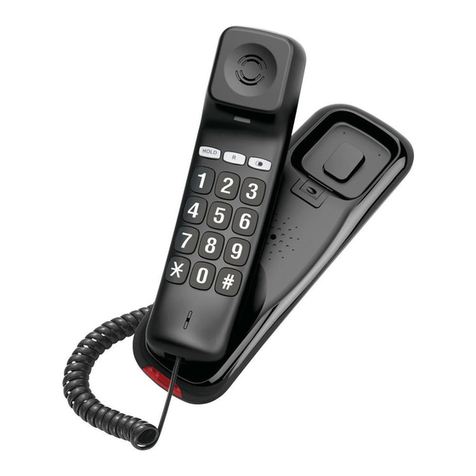
Olympia
Olympia 4510 User manual
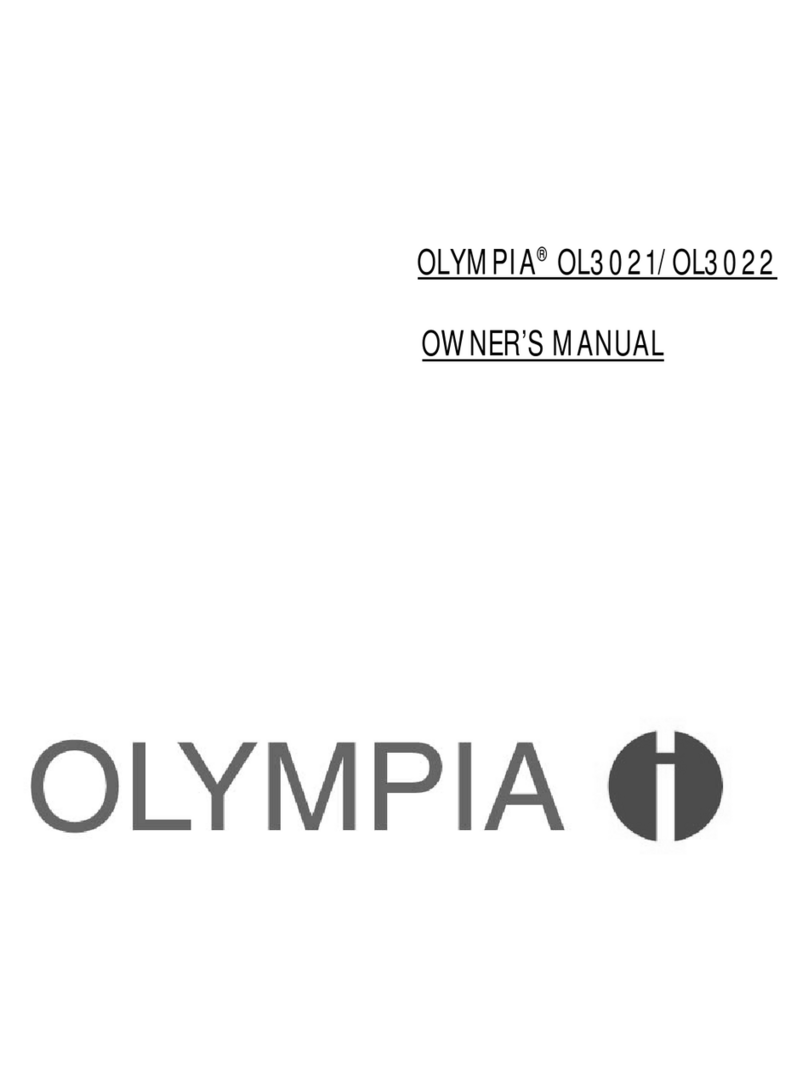
Olympia
Olympia OL3021 User manual

Olympia
Olympia OL2420 User manual
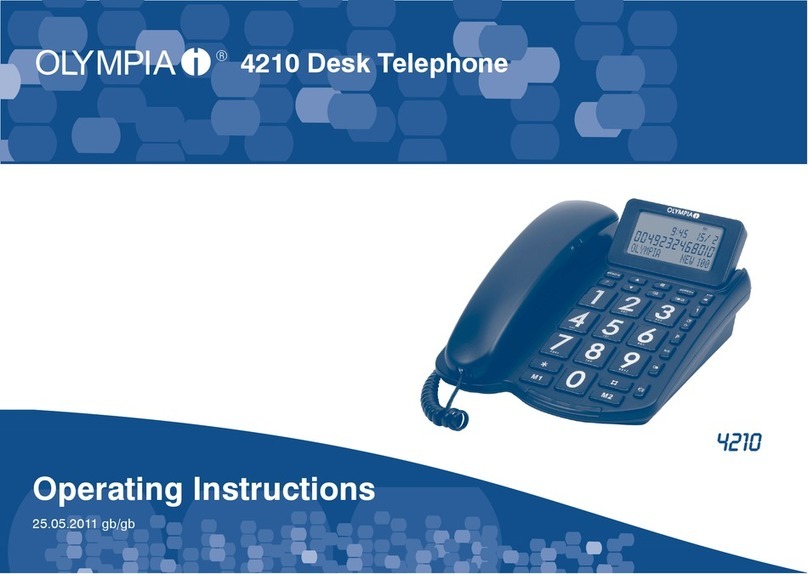
Olympia
Olympia 4210 User manual
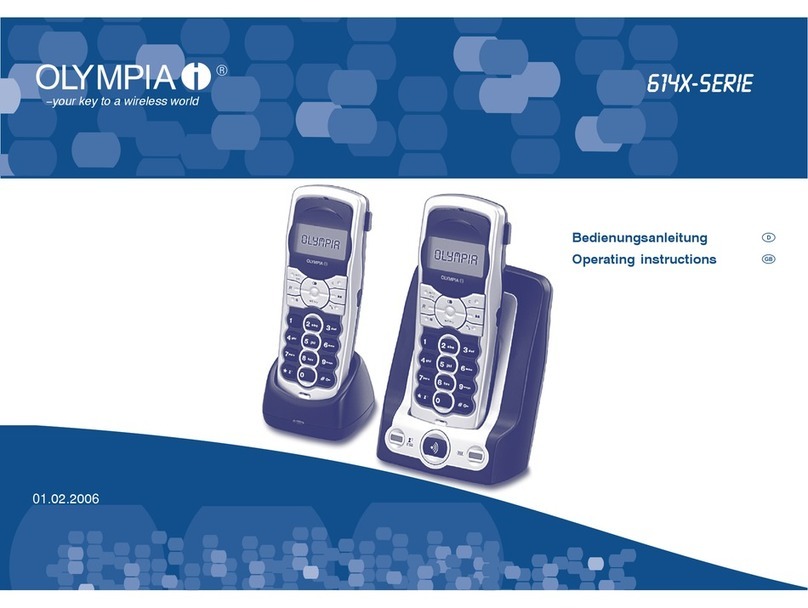
Olympia
Olympia 614X series User manual

Olympia
Olympia 6410 User manual
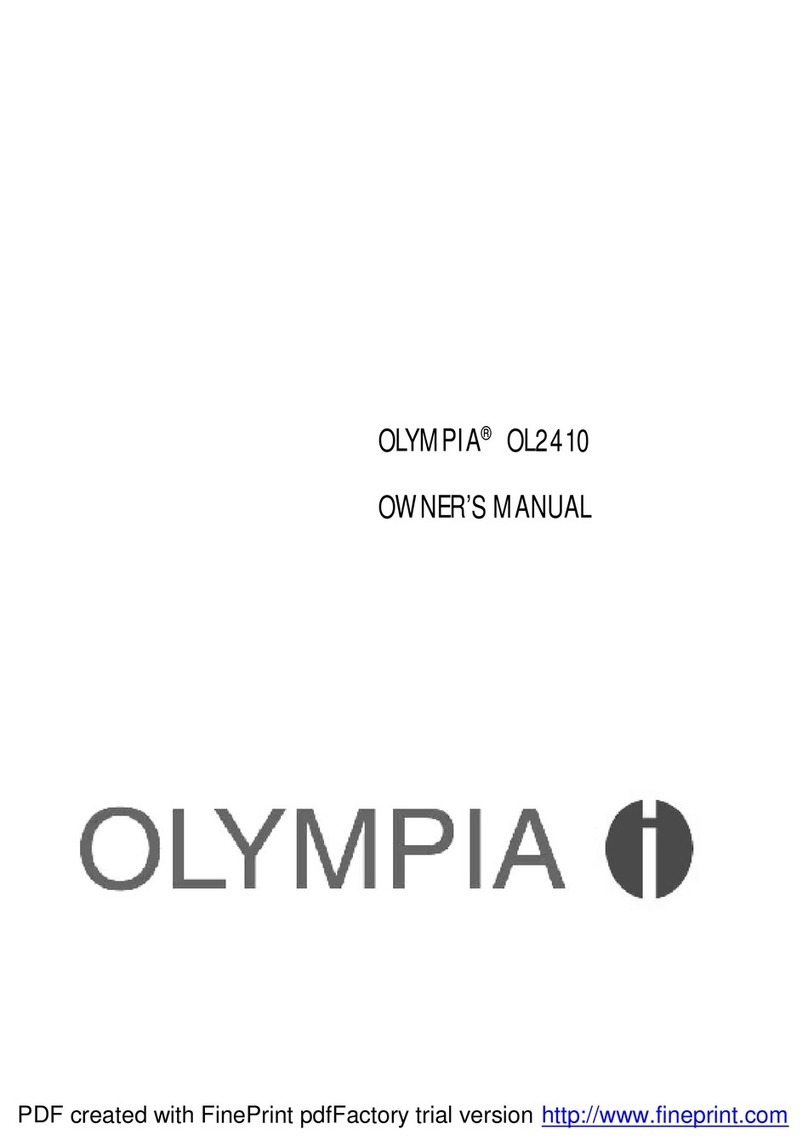
Olympia
Olympia OL2410 User manual
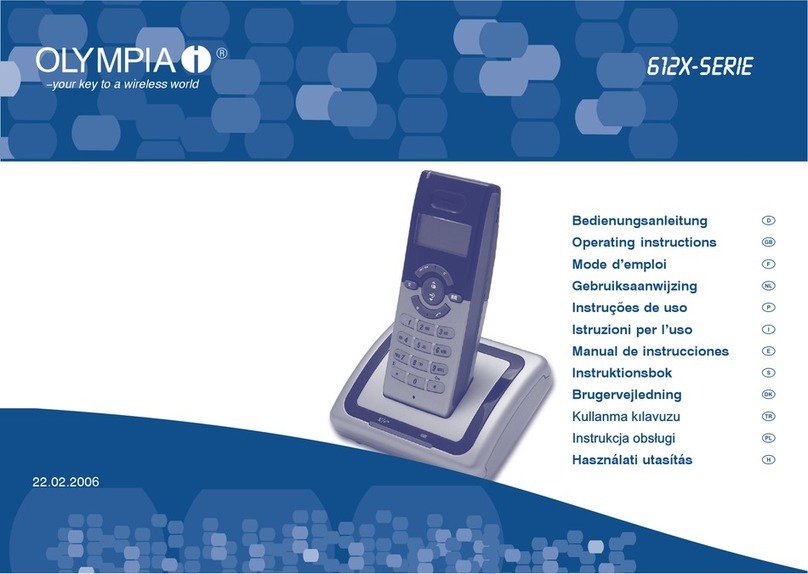
Olympia
Olympia 612X series User manual
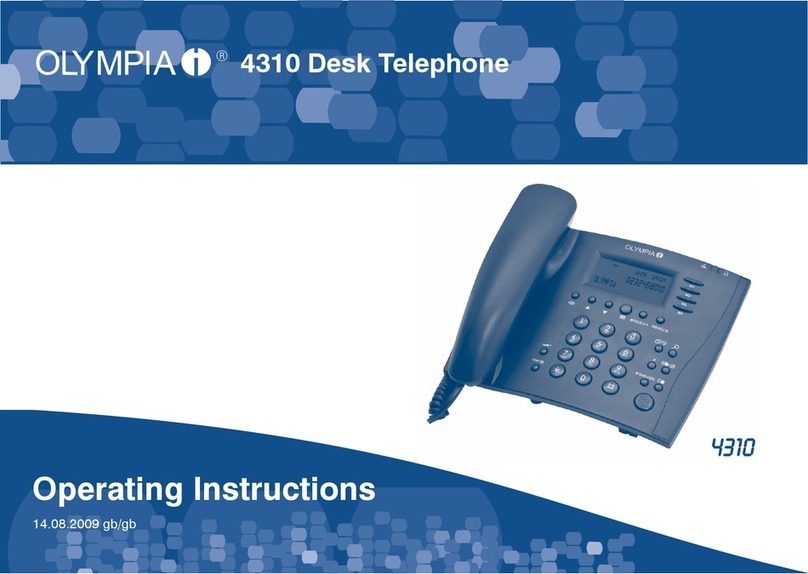
Olympia
Olympia 4310 User manual

Olympia
Olympia Smile User manual

